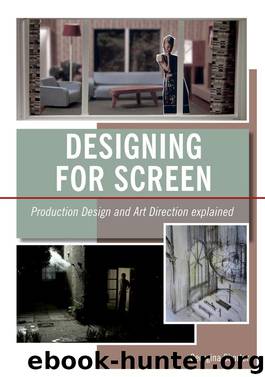Designing for Screen by Georgina Shorter

Author:Georgina Shorter [Georgina Shorter]
Language: eng
Format: epub
ISBN: 9781847974464
Publisher: Crowood
Published: 2012-05-02T04:00:00+00:00
Fig. 63 Storyboard for a commercial. Original outlines were hand drawn, scanned, then inked in with watercolour. (Production Designer: Jane Morton)
The storyboard process happens during the very early stages of pre-production, sometimes called pre-visualization. The Director sits with the storyboard artist and together they work through the story. It gives the Director, Production Designer and DoP a reference base to discuss and agree visual language and style, the lighting and the practicalities of achieving each shot, as together they are responsible for everything in each frame. This process is a way of committing to a creative direction, and ensures that all departments move forward together.
Through the storyboard, the Production Designer will get a feel for how the story will be told, and how the settings will be used and lit. It is a useful reference for the design team. The storyboard is also the source for the shooting schedule; all the information about each camera set up, the duration of each shot, the location, and the action are all worked into the shooting schedule. This is the schedule that all departments on the production work to.
Storyboards range from highly detailed professional industry standard to crude line sketches, but their purpose is always the same whether they are for film, television or commercials. They are a device for communication, a visual guide that all departments refer to and adhere to throughout the whole production process (see Fig. 63).
The world of concept and illustration art can be very daunting. Inexperienced artists must persevere to reach the top, where competition is fierce. Keeping up-to-date with new technologies is essential. Like most areas of screen design, storyboarding is embracing the digital age. To remain competitive, most artists will not only have the ability to draw by hand but be familiar with digital techniques such as animatics – which is a digital moving storyboard program.
New ways to create storyboards are becoming more popular. They can capture the image, mood, lighting, camera angle with greater immediacy, making it a far more effective way of working, if drawing is a struggle. Director Drew Pautz discusses the benefits:
We did the storyboard via digital camera (which works brilliantly), utilizing of course the fact we were shooting in the house (the Director’s home). So Phil Fisk (DoP) came over numerous times and we took all kinds of stills, then we discussed and figured out the shots and assembled them…
(Interview with the author, 2011)
Download
This site does not store any files on its server. We only index and link to content provided by other sites. Please contact the content providers to delete copyright contents if any and email us, we'll remove relevant links or contents immediately.
Wonder by R.J. Palacio(8504)
Mastering Adobe Animate 2023 - Third Edition by Joseph Labrecque(3810)
Unlabel: Selling You Without Selling Out by Marc Ecko(3619)
Ogilvy on Advertising by David Ogilvy(3546)
Hidden Persuasion: 33 psychological influence techniques in advertising by Marc Andrews & Matthijs van Leeuwen & Rick van Baaren(3511)
Drawing Cutting Edge Anatomy by Christopher Hart(3479)
The Pixar Touch by David A. Price(3386)
POP by Steven Heller(3321)
The Code Book by Simon Singh(3105)
The Art of War Visualized by Jessica Hagy(2966)
Slugfest by Reed Tucker(2964)
The Curated Closet by Anuschka Rees(2935)
Rapid Viz: A New Method for the Rapid Visualization of Ideas by Kurt Hanks & Larry Belliston(2864)
Stacked Decks by The Rotenberg Collection(2836)
365 Days of Wonder by R.J. Palacio(2782)
The Wardrobe Wakeup by Lois Joy Johnson(2752)
Keep Going by Austin Kleon(2722)
Tattoo Art by Doralba Picerno(2618)
Tell Me More by Kelly Corrigan(2617)
